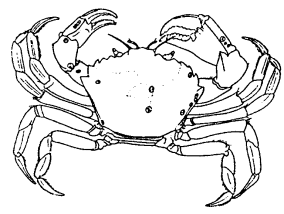 Synonyms: Carcinus
aestuarii, Nordo 1847
Synonyms: Carcinus
aestuarii, Nordo 1847Carcinus mediterraneus Czerniavsky, 1884
 Synonyms: Carcinus
aestuarii, Nordo 1847
Synonyms: Carcinus
aestuarii, Nordo 1847
Common names: Engl: Green crab; Bulg: Kriv rak; Rom: Crabul de iarba; Russ: Travyanoy krab; Turk: Çalpara, Cingene pavuryasi; Ukr: Trav'yany krab
Order: DECAPODA
Family: PORTUNIDAE
Taxonomic descriptions: Large-size crab. Carapace smooth, more or less hexagonal. Posterolateral margin more or less straight, without armature, longer than anterolateral side with 5 proeminent sharps anterolateral teeth. Front produced into 3 low teeth. Short antenulles with 25 articles. Antennae with a very thin flagella. Dactylus of the fifth pleopods normal with a long, cylindrical and slightly flattened craw four times longer than wide; with a strong hialin top. The top of the first pleopods straight or very slightly bent. Size: length - 63 mm, width - 80 mm. Colour: variable - the upper side is generally deep green in adults while the under side is tinged with yellow or red.
 IUCN Status:
IUCN Status:
World level:
Black Sea Regional level:
Subregion level: VU
Distribution:
Habitats type, Critical habitats, Limiting factors: Littoral species, stony algous grounds, common in the fields with Zostera. In winter can reach 30-40 m depth. Inhabits brackish lagoons also. Present throughout the Mediterranean Sea; in the Atlantic it is known to occur around the Canary Islands. As one of the Decapoda species with a high ecological plasticity is a little more resistant to the pollution environment, decrease in eelgrass beds as a preferred biotop.
Biology: Carnivorous species, eats small fishes, shrimps, usually corpses. High prolificity with a long period of reproduction, from May until December. In the period of reproduction makes migrations to the shore. The planktonic larvae (stages of zoea and megalope) are the most resistant of all decapods of the Black Sea. Euryterm and euryhaline species.
Population trends: Up to 1980 was frequent on the Romanian Black Sea littoral, after that it became more rare. A small number of individuals were found during 1991-1995 on the northern Romanian Black Sea littoral.
Threats: Anthropic pressures from largescale coastal hydrotechnical works, degradation of Zostera communities.
Conservation measures taken: Included in the Red Data Book of Ukraine, 1994.
Conservation measures proposed: Reduce eutrophication.
References:
Compiled by: C.Dumitrache